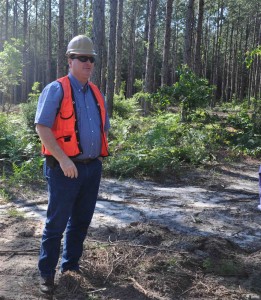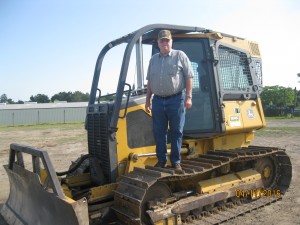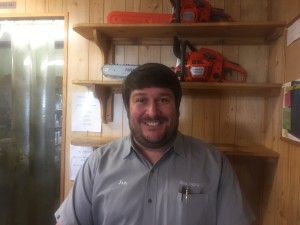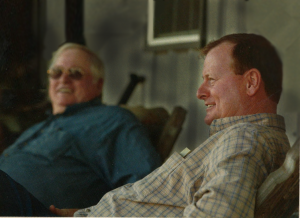Our Staff
Jerry Gray

“Logging seems to be something you are born into. You never hear about someone quitting a stockholder gig to ‘live the life of a logger.” That’s a quote from Jerry Gray in an article for The Forestry Review, and it certainly holds true for him.
Jerry Gray was born in 1961 into a logging family. His Great-Grandpa Thrift helped build a railroad into Billy’s Island in the Okefenokee Swamp. His Grandpa Thrift later logged and helped settle the swamp. His Dad, W.C. Gray, worked in the log woods, even logging out west for a time, and started his own logging company in 1971, when Jerry was just ten years old.
Since that age, Jerry has “lived’ in the woods. At 13, he was using a chainsaw. At 15, he was driving a cable skidder. At 18, upon graduation, he was full-time in the woods. At the age of 40, he became the manager of Gray Logging, LLC. That was nearly 15 years ago.
Today, Jerry still loves the woods as he did as a little boy. Combined with that love is knowledge, experience, and passion.
W.C. Gray
W.C. Gray has always been an important element in Gray Logging, LLC. He began the company in 1971. His hard work paid off and he was able to officially retire in 2001.
Although retired, he still contributes greatly to the business. He has many duties, some of which are: getting parts to the woods crews, running the bulldozer to maintain logging roads on certain tracts, holding down the fort at the company’s shop, and giving valuable advice.
When not working, he is at home aggravating his wife, Sylvia, of 55 years and spending time with his 4 grandchildren and 7 great-grandchildren.

Josh Ensminger

Josh Ensminger was born and raised in the foothills of Tennessee. He ventured south to Florida in 2004 and has been a significant part of Gray Logging, LLC ever since. He is responsible for truck DOT compliance and maintenance, along with being shop supervisor.
Because of his upbringing, Josh has a great love for the outdoors and a desire for others to understand the relationship between man and nature and the necessity for utilization. Hence, helping others understand the importance of timber harvesting, the value of the everyday products which are made from wood that we often take for granted, and the importance of our company within the community.
Josh is happily married to Elizabeth and they have two adorable children, Emmalin and Caleum. They are members of the Azalea Church of God in Valdosta, GA where Josh enjoys playing on the church’s softball team.
Our History
 By the same token, we’ve all heard countless tales of the second or third generation of logging family selling out to pursue other interests. Imagine, then, a modern, thriving logging operation that can trace its roots back to the late-19th century. A family that has been logging continuously for over a century.
By the same token, we’ve all heard countless tales of the second or third generation of logging family selling out to pursue other interests. Imagine, then, a modern, thriving logging operation that can trace its roots back to the late-19th century. A family that has been logging continuously for over a century.
“What I’ve been told bt my granddaddies is we came out of North Carolina – both Mom and Dad’s sides of the family – after the Civil War.” Jerry Gray, current head of Gray Logging of Madison, Florida, tells us, before motioning over to his wife. “Ginger’s family did, too, and wound up in South Georgia.”
Jerry is recounting his family’s history in W.C.’s Kitchen, a kitchen that doubles as a break room attached to the office and shop of his company. Ginger is seated next to him, while his father, W.C., the kitchen’s namesake and Gray patriarch, sits at the nearby breakfast bar. Although W.C. is retired a decade ago, he is still a daily fixture at the shop.
Jerry continues, “Grandpa Gray told me that his grandpa, or great-grandpa, used to hew cross-ties out with broadaxes back when they hauled them out with oxen. This was around 1880-1890 – they were building the railroads.” Railroads into the Okefenokee Swamp. “I’ve been told that Grandpa Thrift, my mom’s father, logged and helped settle the Okefenokee Swamp. My Great-Grandpa Thrift helped build a railroad into Billy’s Island – I don’t know if y’all are familiar with Bill’s Island. It was a big settlement.
“A big settlement” is an understatement. Located in the swamp, Billy’s Island was named after a Seminole leader, Bolek, who settlers nicknamed “Billy Bowlegs.” The island was key in taming the 700-square-mile swamp, earning a nearly mythical status in the process. “They had a doctor, a store – it was a community.” Jerry said. “They used to ‘grid’ the cypress. They’d go in and chop all the way around the big trees and then cypress would die. They would go back the following year and saw them down and float them out – they wouldn’t float when they were green.”
To impact the scale of these trees, Jerry tells us, “My great-granddad’s brother, Lon Thrift, lived in a cypress log – as his house. It was that huge.” Jerry tells us how they moved these monster out. “They built the railroad train – a tram train – and then they had a big steam cranes that pulled them from the woods up. Then they loaded them on the cars and brought them out.” Logging in the great swamp was scaled back by the late 1920s, and all but over by the middle part of the 20th century. Jerry adds, “There was no cypress big enough to cut – it was gone.”
The family remained in South Georgia until disaster conspired to take away the area’s remaining timber resources. W.C. recounts the story, “A fire came through in ’52, and everybody knew there was lumber in South Georgia and North Florida, and came to cut that timber. After it was gone, things got bad.”
With most of the harvestable wood gone and the market fractured, W.C. and Jerry’s Uncle James decided to try their hand in an unlikely spot: New Mexico. “James went out there, looked around, and liked it. He came back and loaded us all up in ’57,” W.C. recalls. “It was hilly and rocky – altogether different than we were used to. But we did it, we moved 350,000 feet of logs a week.” Jerry adds, “They worked in a national forest there, and every tree the cut was stamped.” W.C. continues, “We would cut white pine and fir around the Datil range, near Socorro – there’s some beautiful timber up those mountains.”
The weak market eventually followed them west, but an offer back in Georgia prompted another cross-country move. W.C. tells us, “We were there about a year when a big chip mill started up over Fargo, Georgia. James knew the owner, called him, and got a job, so we came back home.”
Once back in Georgia, W.C. and James kept an eye out for other work. “We got called down here, to Perry, Florida,” W.C. tells us. “A lumber company that owned about 100,000 acres in this area hired us, and we moved. We logged with them about 19 years.
“We moved to Madison in ’69, then James and I broke up our partnership,” W.C. explains. By the start of the next decade he was ready for a change. “I woke up one morning and knew I wanted to do something myself,” W.C. recalls. “In ’71, I went to a local dealership, and they had some stuff they had taken from an old boy – it was wore out. I don’t know how I did it, but I took all of it on a $300-a-month lease.” W.C. is grinning while he talks, looking both proud and amazed at this less-than-auspicious start.
“I’d go out every morning with the saw and cut down 40, 45 trees. I had to limb them, drag them to the ramp, and retop them. Then, I’d put a load on the truck and wrestle them up to the mill. I’d get back, and I’d cut a little bit more – when I’d get home, you didn’t have to rock me to sleep!” says W.C., followed by another chuckle.
The Grays relied on family when the business began to grow. “My uncle Buck came on in ’73 – he was with them all in Georgia, and went to New Mexico with them” says Jerry. “He moved on to Chattanooga, but came back when he had found out Daddy started his own business.”
Jerry’s brother, Jackie, came onboard when he graduated high school. “My brother came on in ’78,” Jerry said. “Then me in ’79. But we had worked summers since we were kids. We limbed logs – I can remember the first skidder I ever got on.” W.C. adds, “I tried to discourage them, but just couldn’t. They just took to it like ducks to water.”
The family continued to work together and prosper, relying on chain saws to fell trees until the early ‘80s, when they purchased their first feller buncher. Jerry tells us about his uncle Buck, “He had to cut many a tree with a chain saw, but when the first buncher came to the woods, he would cut one tree at a time, and throw it down. W.C. stopped him and said, ‘Buck, you’re not toting a chainsaw anymore, put them in a pile.” W.C. is quick to add, “He ran that saw. If you hailed five loads, he could cut five. If you’d haul 12 loads, he’d cut 12 – he was always two or three loads ahead. I don’t know how, but he did it.”
Jerry goes on, “Buck worked with us until he retired in ’01.” Of all the challenges the Grays have faced, 2001 may have seen the toughest. “That year, Dad retired, Uncle Buck retired, and I lost my brother. The way we worked together, Buck and Jackie and myself, we didn’t have to ….” Jerry trails off for a second before continuing, “We just knew what each other was gonna do.” Luckily, Jerry, like his ancestors before him, didn’t back down. “Work was my healing, but I still miss him every day.”
The company Jerry heads up is very different from even 10 years ago. Gone are the days of paper companies and mills owning the timber. Jerry has had to learn how to buy tracts and makes agreements with landowners himself to keep his two crews busy. “I love the position I’m in now,” Jerry enthuses. “I love meeting landowners. I get phone calls from consultants, and they say, ‘I got a Jerry Gray block.’ That means the landowner wants things done a certain way. It’s a challenge, but I enjoy it.”
Although the Grays continue to face the day-today challenges most loggers face – like rising fuel prices and uncertain supply of wood – they do so by relying on a rich tradition to thrive. Ginger sums it up nicely, “It’s a family business. This is our life, it’s not just a job.